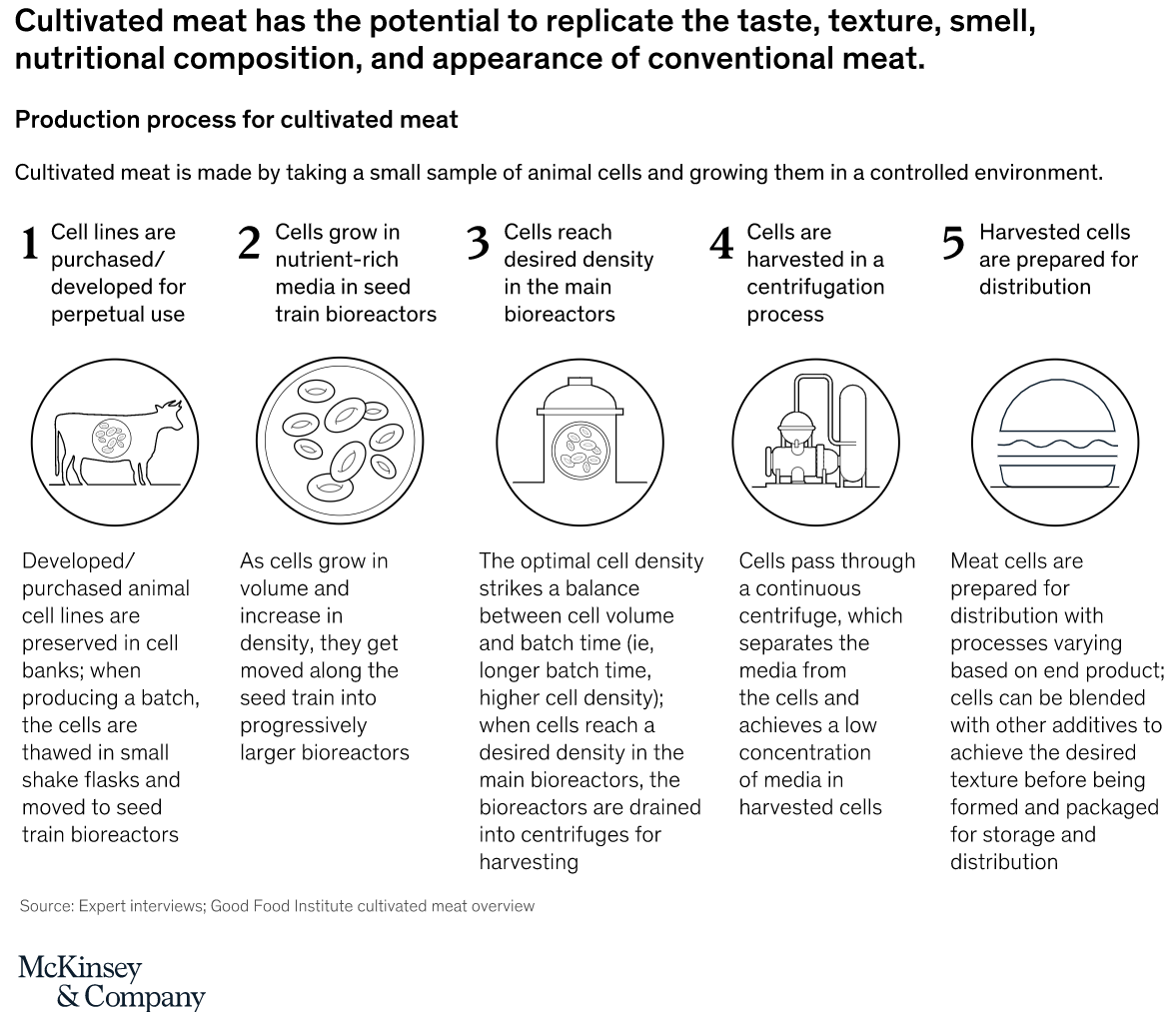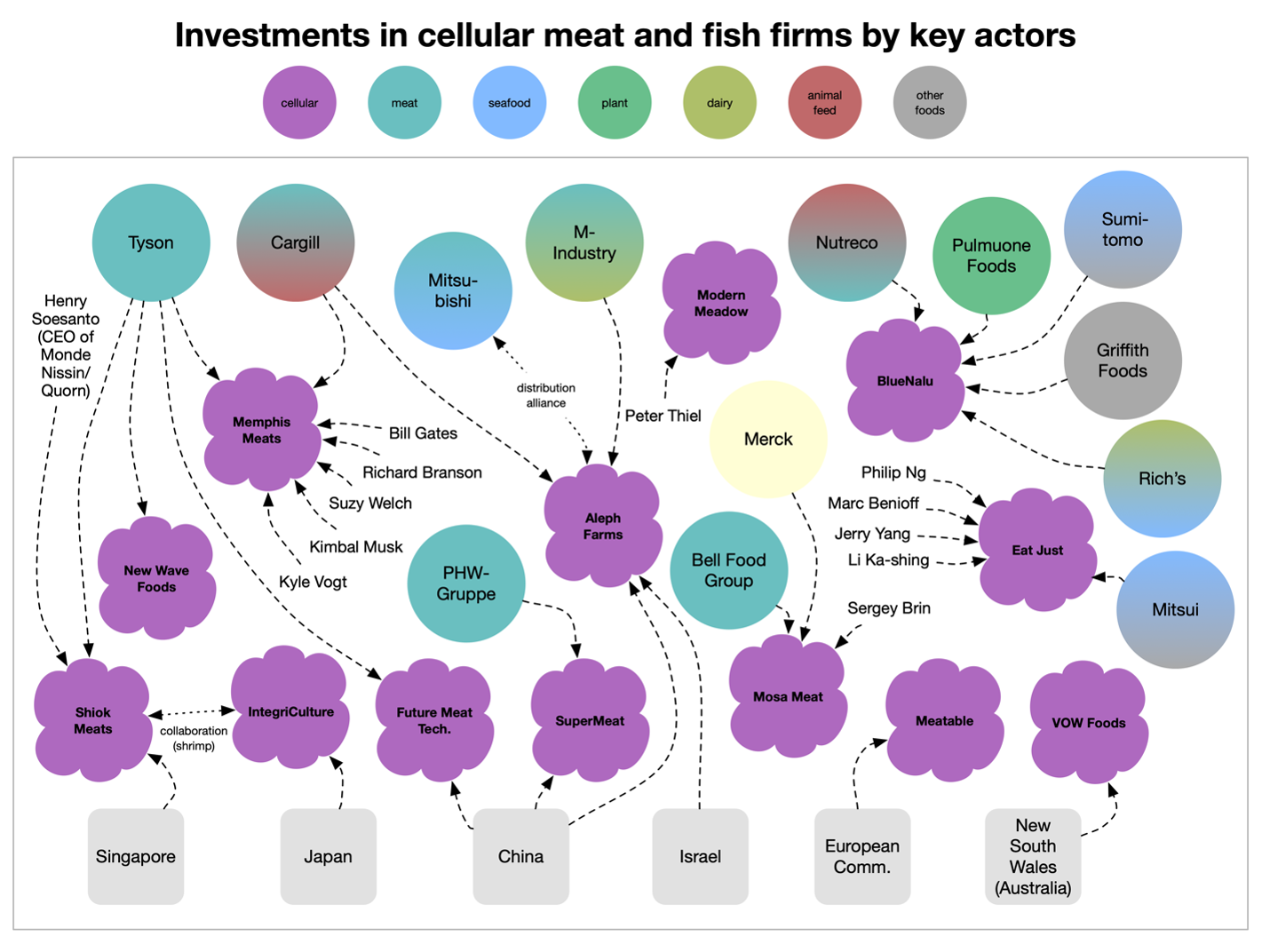🧫Understanding the Limits of Cultured Meat

Innovation: Whenever I speak to folks who are first learning about regenerative beef, they ask if it’s synonymous with cultured meat. And with over $3.1 billion raised by alternative proteins in 2020 and venture capital fundraisings for cultured meat startups in the tens to hundreds of millions announced every month (totaling $250M in the first half of 2021), who can be blamed for the confusion, especially given the hype for both terms? Cellular agriculture presents incredible technical ambition from folks who aim to do good in shifting us away from the industrial meat production system. New York Times columnist Ezra Klein’s framing of a “moonshot for meatless meat” shows how this space elicits excitement for policy wonks, entrepreneurs, and folks coming from a diverse group of backgrounds.
However, as recent deep dives into the nascent industry point out, scaling cultured meat production for mass consumption might not achieve technical feasibility at attractive price and production points. It also comes with a higher than anticipated environmental footprint (primarily due to energy consumption) combined with negative socio-economic and health-related externalities. The key risk here, beyond technical failure, is the replication of the industrial commoditized beef system it is attempting to supplant. As these cultured meat products start being commercially available and cross regulatory hurdles, particularly in countries like Israel and Singapore, we should understand the costs - financial and environmental - of scaling cultured meat and how it compares to alternatives.
Recent literature in scientific journals and by journalists make the following points:
Intellectual property can lead to market consolidation and cutting out producers.
As Tim Hayward quips, intellectual property protections in the cultured meat space will change “meat” to “Meat™.” Though meat processing is quite consolidated, there is a somewhat adversarial relationship between producers and the big corporations that pack and trade commodity beef. These big corporations would be able to leverage their entire distribution channels and higher profit with more patented food products, while the only “producers” they would need to build relationships with are ones they would need to harvest animal cells from or “farmers” with input materials for scaffolding the cells into meat and “feeding” the cells. Patents could occur at a product level or across the whole process (see image below). Companies like Cargill, Tyson Foods, and Merck are early investors in the space, for instance, and stand to gain immense control of our food system if the cultured meat movement is successful. This is a key profit-driving opportunity that cellular meat activists could argue will be worth it given the environmental savings of cultured meat. However, if these folks are seeking profit primarily, then the way they utilize cellular agriculture might end up being equally or more harmful to industrial beef.

Compared with the range of uses from and positive ecosystem services performed by well-managed cattle, cultured meat can be myopic and energy-intensive.
Fundamentally, cultured meat is not prima facie climatically superior to cattle, and most life cycle assessments and comparisons between cultured meats and cattle do not consider the range of practices available to raise cattle beyond destructive centralized feeding animal operations(CAFOs). As animal geneticist Alison Van Eenennaam retorts, “we already have self-propelling, self-cleaning, solar-driven bioreactors = [cattle].” While cattle produce more methane, these emissions do not accumulate over long periods of time - unlike CO2 emissions from energy expenditure. Thus, cultured meat’s environmental footprint is entirely dependent on the availability of decarbonized energy generation, while cattle can help sequester carbon in natural settings when properly managed. Furthermore, comparative LCAs between cultured meat and beef require more transparency - for example, the LCA of cattle farming used in these comparative studies measures water use that include all the rainfall in a given area, while also not accounting for the environmental footprint of where inputs for cultured meat products are sourced. Cultured meat is not made out of thin air, and the system that it comes from will never be able to generate the ecosystem services that cattle can, nor the variety of products that utilize beef by-products. It also bears mentioning that most of the rangeland used for livestock production is too marginal for cropland conversion, and doing so has disastrous consequences.
Recent Techno-Economic Analysis of cultured meats point to widely recognized biological limits and require a series of “Nobel Prize-worthy” advancements to succeed at scale.
A TEA from Open Philanthropy, one of the biggest donors to the Good Food Institute (the major advocates for cultured meat) point to “Capital- and operating-cost analyses of conceptual cell-mass production facilities indicate economics that would likely preclude the affordability of their products as food.” While cultured meats have an incredible feed efficiency, the costs of building new facilities would take away any profitability. Issues here exist across the board: the best existing cultured meat growth media is fetal bovine serum(FBS), which is extracted from cattle fetuses during processing. Given that the extraction would require “meat with slaughter”, finding an alternative growth medium has proven costly. Even in a GFI commissioned report, this pain point had minimal detail beyond needing to reduce these input costs to achieve cultured meat costs. Furthermore, macronutrient inputs, like amino acids, inputs also are needed to grow cultured meat cells. The best way to do so, ironically, is to derive these amino acid profiles from commodity soy, though even this is still speculative. However, this cheap soy is produced in a vast monoculture that is overfertilized, and globally leads to deforestation.

This is not to say that we won’t be seeing cultured meats at cultured high-end restaurants in the next few years. However, these three areas need to be top-of-mind as we tackle cultured meat. The USDA and FDA are both tackling the labeling of cultured meat currently and accepting public comment. We should keep asking questions about this novel approach in order to refine which use-cases cultured meats might fit - and keep the context of regenerative grazing and nature-based solutions in mind. For example, there are potential issues with pathogens in cultured cells, particularly at a factory scale. There is no prohibition on hormones for cellular meat production, nor regulation on micronutrient profiles for cellular meat profiles(both of which do exist for meat). We should know whether growth hormones will be present in trace amounts in the end product, particularly because, as The Counter report notes, operators have gotten cultured cells sick before quite easily.
Given the acceleration of risk capital into this space, investors and entrepreneurs should consider whether they will get more bang for their buck in terms of climate impact and financial returns from nature-based solutions to agricultural emissions, like regenerative beef, or engineered solutions like cultured meat. As the GFI’s Europe spokeswoman correctly notes, regenerative agriculture and cultured meat both are working to end industrial-scale animal farming. However, concrete examples are helpful to showcase the new options available to consumers. Foie Gras conventionally comes from forced feeding practices and has been banned in various areas. Due to ingenuity and innovation, there are now two “new” ways to produce it: You can follow the path of Eduardo Sousa and ethically raise geese for Foie Gras with myriad ecosystem services or we can now consume lab-grown foie gras. Rather than support a centralized, corporate approach that does not have positive externalities, I would support Sousa and ecosystem-supporting products when possible. Regenerative and agroecological practices can help end world hunger, provide livelihoods to millions, and do myriad (unpaid) ecosystem services. As a colleague of mine likes to say, “We can't solve problems by using the same kind of thinking we used when we created them” (Albert Einstein). Investing in a paradigm shift from purely engineered and extractive approaches to climate change and toward a technology-enabled regenerative approach in tune with nature will yield more fruits over time.
Shop: Check out the Regeneration Nation collection! Regeneration Nation aims to be the brand for the heroes and advocates of regenerative agriculture. Regeneration Nation is partnering with The Savory Institute for its inaugural collection. Collection 01 consists of one item, the "R.O.D. Soil Tee." $5 from each t-shirt sale will be donated to The Savory Institute. Rock one. Spread the word. Help fund the regeneration. These shirts are only available for a limited time.
Listen: If you’re not sick of me yet, listen to your author here discuss carbon credits with ranchers CK Wisniewski and Brian Alexander on the Ranching Reboot podcast. We go over the carbon credit market and the risks to producers, as well as my path into regenerative agriculture and why it means so much to me these days. It’s a good discussion on what it will take for regenerative grazing and soil carbon markets to scale and an unfiltered view on how independent producers are approaching it, too. Let me know what you think!
Disclaimer: The Regeneration Weekly receives no compensation or kickbacks for brand features - we are simply showcasing great new regenerative products.
If you have any products you would like to see featured, please respond to this newsletter or send an email to Kevin(at)soilworksnaturalcapital.com
The Regeneration is brought to you by Wholesome Meats | Soilworks | Grassroots Carbon| Grazing Lands





Good summary. The cost and risk to develop and scale animal cell based cultured meat alternative proteins is prohibitive. There are major risks such as bacteria or viruses getting into the manufacturing process. Investors need to consider the risks as they are significant...
Suggest having a look at this article...
https://thecounter.org/lab-grown-cultivated-meat-cost-at-scale/?fbclid=IwAR0TYn8WSQWxJx-xY6ekjad1MXqEz5sXh6QhgOEkPmcgDgY39In2tYe_vtw
Great analysis and summary of all the salient issues here. Thanks for doing.